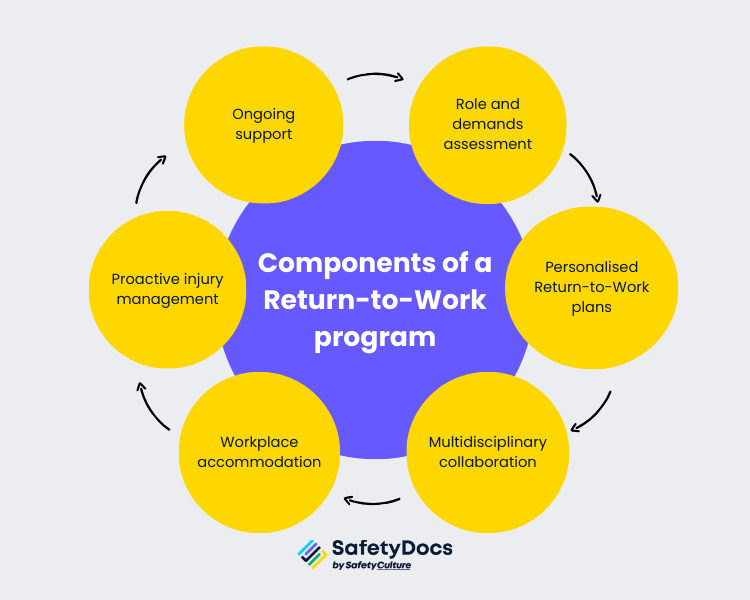The more time employees spend away from work, the less likely they are to return. According to the National Return to Work Survey by Comcare and Safe Work Australia, the longer a worker is away, the lower the chance they'll return after an injury. Key findings include a 70% likelihood of injured workers returning to work after 20 days off and a 50% likelihood of returning to work after 45 days off.
The survey shows a gap in return-to-work planning, with about 1 in 4 injured employees requiring a formal plan for their workplace transition. This shows the need for employers to adopt proactive measures to support their workforce.
Let's explore essential strategies and best practices for facilitating a smooth and successful return-to-work program for injured employees.

What is a Return-to-Work Program?
A Return-to-Work (RTW) program is a structured approach designed to help employees absent for extended breaks from the workplace - typically due to injury, illness, or other personal reasons - transition back to work safely and in a supportive manner. These programs aim to speed up recovery, maintain productivity, and reduce the costs of prolonged absences.
Components of a Return-to-Work Program
1. Role and Demands Assessment
This entails comprehensively analysing the employee's job role and physical demands. It offers valuable insights into the job's physical, cognitive, behavioural, and environmental requirements, which are crucial for safely aligning an employee's abilities with the job's demands.
2. Personalised Return-to-Work Plans
Personalised return-to-work plans are essential for facilitating a smooth transition back to work. These plans should consider the employee's restrictions, abilities, and job demands. A gradual increase in responsibilities and work hours helps build confidence and prevents re-injury.
3. Multidisciplinary Collaboration
Multidisciplinary collaboration involves professionals from various fields working together, including the employee, healthcare providers, supervisors, and human resources, for successful return-to-work outcomes. Open communication ensures all stakeholders are aligned and the employee receives support.
4. Workplace Accommodations
Workers returning to work after an injury may require additional accommodations, such as ergonomic equipment, modified duties, and altered schedules. Employers should make reasonable adjustments to support employees' safe return and well-being.
5. Proactive Injury Management
Early intervention is critical for successful RTW outcomes. Promptly reporting injuries and providing appropriate care can significantly speed up recovery and reduce absences. Employers should encourage a culture of early reporting and provide resources for employees to seek medical attention.
6. Ongoing Support
Returning to work post-injury needs ongoing support. Employers should regularly check their employees to evaluate progress, address concerns, and adjust the return-to-work plan.
National Return to Work Strategy 2020-2030
To address the gaps in return-to-work planning, the Australian government has released a National Return to Work Strategy 2020-2030. This is a 10-year initiative developed by Safe Work Australia to improve return-to-work (RTW) outcomes for injured or ill workers across the country. It presents a thorough, enduring strategy to tackle the obstacles hindering prompt and effective employee return to work.
The strategy has five key action areas:
Action Area 1: Supporting Workers
- Educate workers on compensation system, rights, and health literacy
- Understand workers' psychological responses to work-related injury for better recovery
- Promote best practices for client-centric, coordinated return to work
Action Area 2: Building Positive Workplace Culture and Leadership
- Investigate stigma causes and impacts on injured workers; campaign to change perceptions
- Promote best practices and leadership for positive workplace relationships
Action Area 3: Supporting Employers
- Enhance capability development for employers and staff to support workers and coordinate safe, timely returnship.
- Advocate for best practices in providing suitable duties and workplace adjustments for a safe, timely return to work.
- Promote return-to-work programs, policies, and plans aligned with the Strategy's principles.
- Customise national actions to address the needs of small and medium businesses.
Action Area 4: Supporting Stakeholders
- Apply principles of good work
- Promote tailored, client-centric best practices
- Investigate early intervention and claims management models
- Develop national return-to-work measures to assess stakeholder impact
Action Area 5: Building and Translating Evidence
- Conduct an in-depth analysis of the National Return to Work (NRTW) Survey to pinpoint areas for improvement.
- Seek opportunities to enhance the existing NRTW Survey.
- Pursue better quality data for the NDS through consistent, comprehensive collection.
- Understand return to work from the employer's perspective.
- Develop a national research agenda to optimise research use and fill evidence gaps.
- Consider creating a national evidence platform for coordinated evidence sharing.
- Coordinate efforts to identify and apply nationally significant research.
Collaboration is Key: Roles & Responsibilities
Any RTW program or strategy will not succeed without collaboration and commitment from all stakeholders. Here are key roles and their responsibilities for a successful return-to-work process;
Employers
In Australia, employers are categorised into two groups based on their Average Performance Premium (APP) for workers' compensation insurance. These categories determine the specific obligations and requirements for implementing Return-to-Work (RTW) programs:
Category 1 Employers
These are employers whose APP exceeds $50,000 per year.
Work Obligations:
- Align the RTW program with State Insurance Regulatory Authority (SIRA) guidelines
- Appoint a Return-to-Work Coordinator (RTW Coordinator)
- Ensure the RTW Coordinator is adequately trained and experienced.
- Address essential topics such as leadership, workplace arrangements, rights, incident support, recovery, dispute resolution, and administration
- Display or notify the RTW program prominently at the workplace
- Review the RTW program every two years with relevant parties
Category 2 Employers
These are employers whose APP is $50,000 or less per year.
Work Obligations:
- Appoint a recovery coordinator
- Create an RTW program for work-related injuries and illnesses
- Roll out the RTW program
- Consult workers and unions when developing/reviewing the RTW program
- Train the recovery coordinator adequately
- Review the RTW program every two years
Additionally, employers should also designate an approved workplace rehabilitation provider for the RTW program.
Employees
- Actively participating in developing their RTW plan and communicating any concerns or needs
- Adhere to treatment plans, attend all medical appointments, and provide updates on their condition and capabilities to their employer and healthcare providers.
Healthcare Providers
- Perform comprehensive evaluations of an employee's condition and work capacity.
- Develop and oversee treatment plans to ensure a safe and effective workplace return.
- Communicate clearly with the employee, employer, and other medical professionals involved in the return-to-work process.
- Provide the necessary medical documentation outlining the employee's capabilities and limitations.
Insurers/Claims Managers
- Handle workers' compensation claims efficiently and support the RTW process
- Offer resources, such as rehabilitation services, that facilitate an effective RTW
- Act as a liaison between the employer, employee, and healthcare providers
- Ensure timely and accurate payment of benefits to the injured employee.
RTW Coordinators
- Assist in the creation of individualised RTW plans based on the employee's specific needs and circumstances
- Oversee the RTW process, ensuring all parties fulfil their roles and follow the plan
- Address any issues or barriers that arise during the RTW process
- Provide training for supervisors and employees on RTW policies and practices
Supervisors/Managers
- Provide day-to-day support to the returning employee, including monitoring their workload and adjusting tasks as needed
- Observe the employee's performance and well-being, and report any concerns to the RTW coordinator or relevant personnel
- Offer encouragement and support to build the employee's confidence and morale.
Unions and Employee Representatives
- Advocate for fair treatment and support for injured workers
- Help mediate any disputes or issues that arise between the employee and employer
- Provide additional support services or resources to assist in the RTW process

Legal and Regulatory Compliance
Regulations and laws are also in place to ensure all parties effectively fulfil their responsibilities. Various federal and state laws in Australia govern legal and regulatory compliance for RTW programs. Using NSW as an example, key regulations and laws can include:
Disclaimer: This information is based on the regulations in New South Wales (NSW). Regulations and laws for RTW programs can vary across different states and territories in Australia. Please check the specific regulations and laws applicable to your state or territory.
State Insurance Regulatory Authority (SIRA) Guidelines
SIRA Guidelines for Return to Work Programs
- These guidelines outline requirements for employers to create effective RTW programs, emphasising worker consultation, timely and safe recovery, and confidentiality.
- Outline the specific requirements for Category 1 and Category 2 employers, including the need for a written RTW program, consultation with workers and unions, and regular reviews.
Workers Compensation Laws
- Workers Compensation Act 1987 (NSW): This law ensures compensation for workers injured at work and defines employer and worker responsibilities in such events.
- Workers Compensation Regulation 1998 (NSW): This regulation outlines employer requirements for managing workers' compensation claims, including return-to-work programs and work related injury reporting procedures.
Privacy and Confidentiality
- Privacy Act 1988 (Cth): This federal law outlines principles for handling personal and health information, requiring informed consent and secure record-keeping.
- Health Records and Information Privacy Protection Act 2002 (NSW) and Privacy and Personal Information Protection Act 1998 (NSW): State laws that guide managing personal and health information in workers' compensation claims.
Insurer Requirements
- Injury Management Program: Insurers must develop strategies for managing work-related injuries, and employers must align their RTW programs accordingly.
Review and Display
- Display of RTW Program: Employers must display or notify their RTW program. Category 2 employers can provide it upon request or to those with a worker's compensation claim.
Disability Non-Discrimination Laws
In Australia, the Disability Discrimination Act 1992 (DDA) prohibits discrimination against people with disabilities in areas like employment, education, and public services. Key provisions of the DDA relevant to RTW programs include:
- Employers should offer reasonable accommodations for disabled workers, such as flexible hours and specialised equipment.
- It's legal to refuse a job if a disability prevents essential duties, but adjustments must be considered.
- Employers must avoid making changes that cause major difficulties or costs but must show why.
- The Australian Human Rights Commission addresses complaints of discrimination under the DDA. Discriminated individuals can file complaints.

How to Implement RTW Programs Effectively
Implementing Return-to-Work (RTW) programs effectively requires a well-structured approach that involves planning, communication, and continuous evaluation. Here is a step-by-step guide to help organisations implement RTW programs successfully:
1. Develop Clear Policies and Procedures
Create comprehensive RTW policies that outline the steps for managing injured employees' return to work. Ensure these policies comply with relevant laws and regulations—document specific procedures, roles, and responsibilities for all stakeholders.
2. Conduct Workplace Assessments
Evaluate the workplace to identify potential hazards and opportunities for accommodating injured workers. This includes assessing job tasks to determine which duties can be modified or adjusted to suit the employee's capabilities.
3. Offer Modified Duties
Identify and provide suitable temporary or permanent modifications to job tasks. Ensure these duties align with the employee's current abilities, skills and medical restrictions, promoting gradual reintegration into their regular role.
4. Monitor and Evaluate Progress
Continuously monitor the employee's progress and the effectiveness of the RTW plan. Hold regular review meetings to assess the employee's condition, adjust duties as needed, and ensure the RTW process remains on track. Encourage open communication between all stakeholders.
5. Collect Data and Feedback:
Gather data on RTW outcomes and solicit feedback from employees and other stakeholders. Use this information to identify areas for improvement and refine RTW policies and procedures. Regular data analysis can also help the company track trends and identify patterns in workplace injuries.
6. Utilise Documentation
Document all steps to manage the employee's return to work, including medical appointments, meetings, and progress reports. Accurate documentation can help defend against potential legal claims related to the RTW process.
Use SafetyDocs for Smooth Return-to-Work Programs
SafetyDocs by SafetyCulture offers safety documentation that simplifies creating, managing, and distributing essential workplace documents such as RTW policies and procedures. Organisations can easily customise templates to make clear and comprehensive documents and policies that comply with relevant laws and regulations.
Use the following SafetyDocs templates to help implement a successful RTW program:
- Return to Work Management Policy
- Occupational Health & Safety Policy
- Fitness for Work Plan
- Incident & Investigation Report Form
Using SafetyDocs to implement your return to work program will ensure your organisation complies with relevant laws and regulations and promotes a safe and healthy workplace culture. Contact us today to learn how SafetyDocs can support your employees returning to work.
Our team of experts is dedicated to providing accurate and informative content. Craig Cruickshank, our senior HSEQ advisor at SafetyDocs by SafetyCulture has reviewed this blog post to ensure the highest level of quality.
Learn more about Craig's work on LinkedIn for more industry insights.
Available for instant download and supplied in fully editable MS Word format for use in your business.
Please note that the above information is provided as a comment only and should not be relied on as professional, legal or financial advice.
Share This Article
